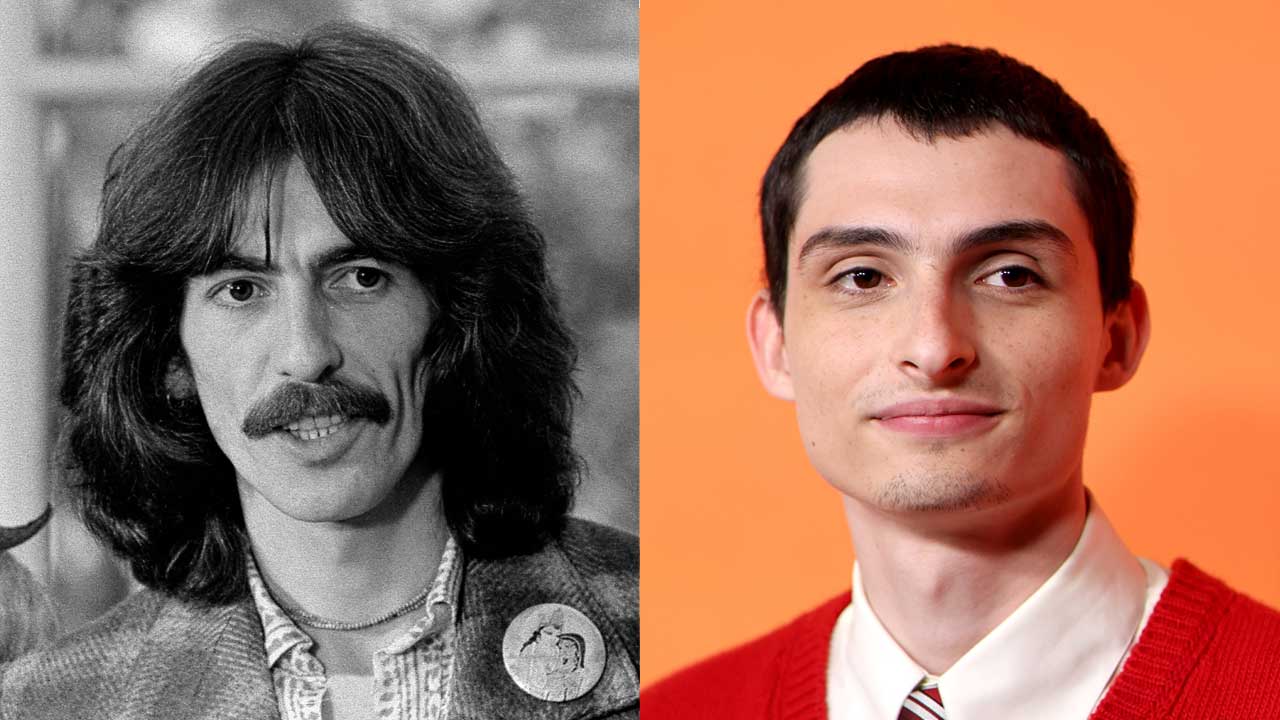Troublemakers: Vintage Trouble Want To Slap You In The Face
… With their high-energy cocktail of R'n'B'n'soul, obviously. Working with Booker T, touring with AC/DC, signing to Blue Note – inside their unstoppable rise…
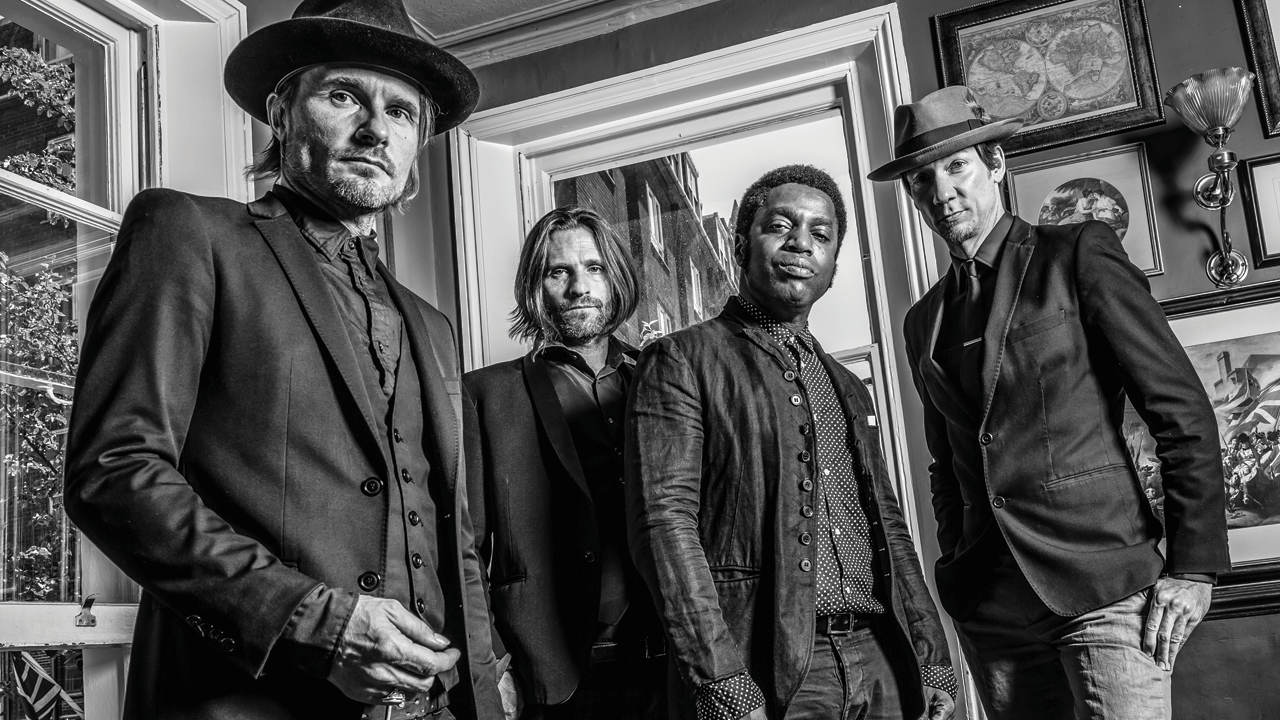
It’s an unforgivingly hot summer’s day in London.
Most folks are shedding layers in an effort to keep cool, but when Vintage Trouble arrive for their interview with The Blues, they all look sharp as tacks, suited and booted and making no concessions to the heat. The LA-based quartet – frontman Ty Taylor, guitarist Nalle Colt, bassist Rick Barrio Dill and drummer Richard Danielson – stand poised to release 1 Hopeful Rd, their first album on Blue Note Records and the long-awaited follow-up to 2011’s The Bomb Shelter Sessions. It’s a heady blast of raw, soulful energy produced by Blue Note’s president, the legendary Don Was, a man who has worked with musical titans including BB King, The Rolling Stones and Bonnie Raitt. But it was another nigh divine member of the R&B pantheon who introduced Was to the band.
“We started working with Booker T Jones from Booker T and the MGs,” says Nalle Colt. “We ended up writing some music with him that ended up on this new album. We had a local show in Los Angeles, we invited Booker T Jones to come and play. I think Don Was heard that Booker T was playing with this band he’d never heard of, he wanted to check it out. He came down and he couldn’t believe it.”
But although Was signed the band to Blue Note – the first rock’n’roll outfit in the label’s storied history – he needed a little more convincing to produce the album. “Initially he was like, ‘No, no, I’m too old for this,’” says Colt. “Everyone was like, ‘Are you kidding me? You’re Don Was!’ Eventually he came around and thank God – he became the fifth member of the band.”
“It was amazing to be in the studio with him,” says Ty Taylor. “To watch his body transform from being the producer to being a regular person listening to it. He does this thing where he drops his head down, you
just see his head moving back and forth and you can tell that he has become a feeler of the music rather than a thinker of the music, and once it gets into his body then he moves onto, ‘Okay, this is good.’”
The band were keen to retain the live energy of their self-released debut for their vital second album. “On our first record we recorded live with no click,” explains Richard Danielson. “And we were a little nervous that a producer might want to come in and really overproduce on this sophomore record, and what Don did was 100 per cent the opposite. He stripped us down even more.” The band members played live in one room with Taylor in a vocal isolation booth. But to everyone’s surprise, Don Was often sat in the room with them at EastWest Studios in LA. “He sat there as if he was a microphone and he would try to find the sweet spot,” says Danielson. “He would tell the engineer, ‘Look, this is my sweet spot, this is what I want the band to sound like.’ At one point he even asked us to take our headphones off so we could just hear what was going on in the room. He really kept us so honest and pure, which is probably what you want to do with this band. That’s how we love to record. What was nice is that we didn’t have to fight some producer for it. Don Was steered us right back to where we started and that’s a beautiful thing.
Sign up below to get the latest from Classic Rock, plus exclusive special offers, direct to your inbox!
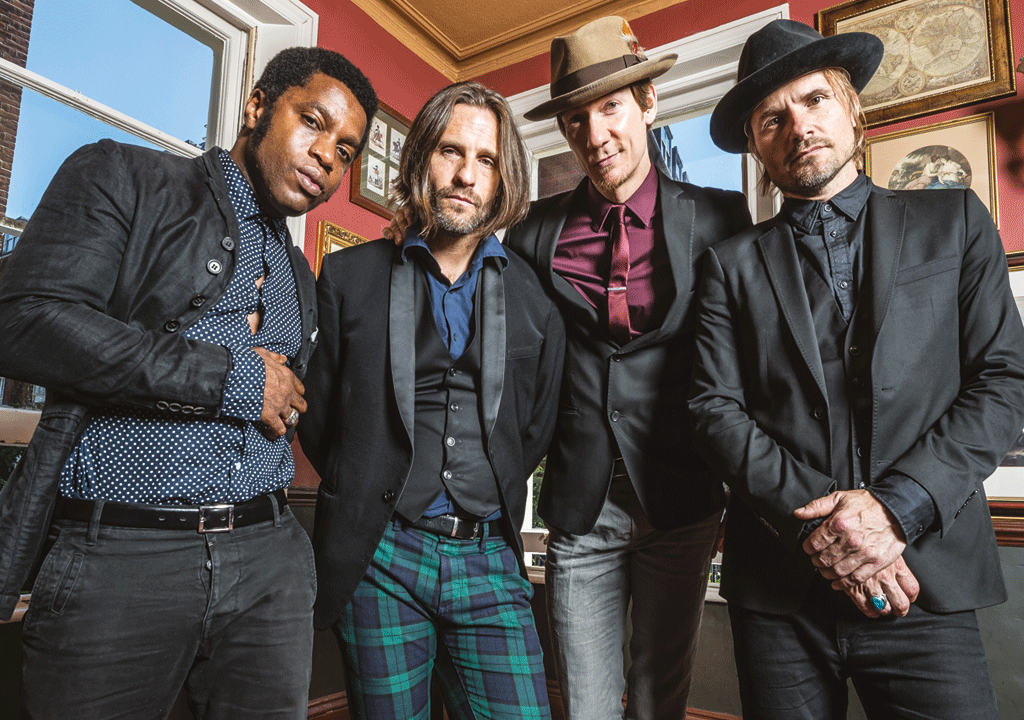
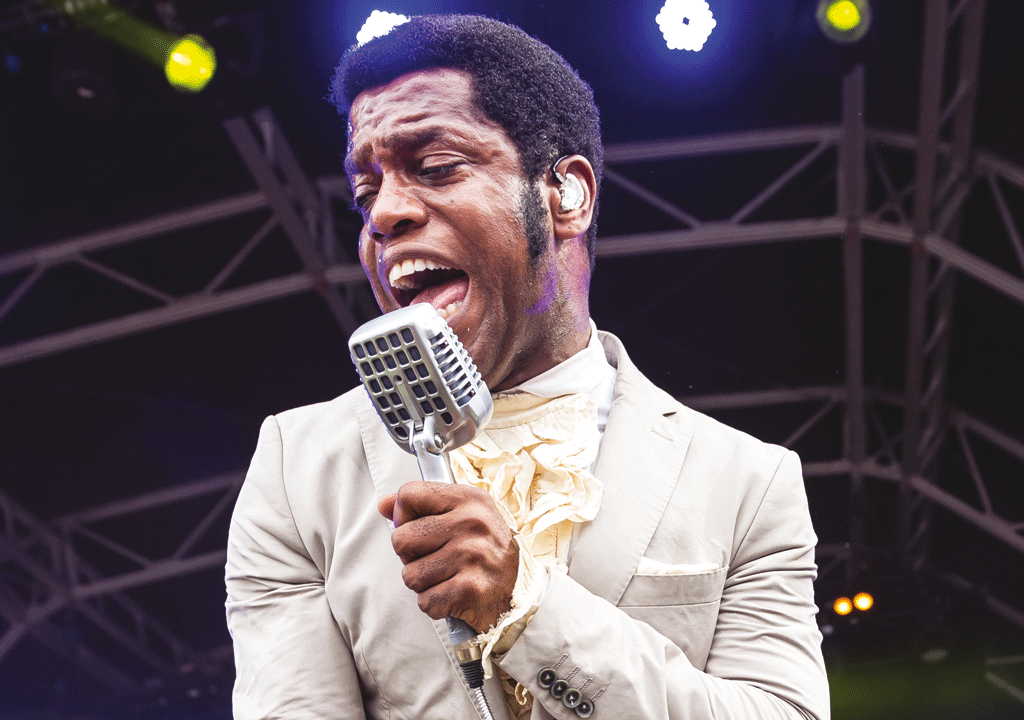
With four years of touring between albums, Vintage Trouble had built up a catalogue of ideas for 1 Hopeful Rd, but even so, some songs on the new record were born on the eve of recording. “Sometimes it’s great to play a song over years and years live and you mould it into what it is, we have a lot of those on the record,” says Colt. “But with some songs it’s the beauty of walking in and not really 100 per cent knowing what’s going to happen. It creates this beautiful energy.”
Their stripped down sound and bristling, bracing sonic propulsion is at once classic and fresh, a reflection of the era and artists that inspire Vintage Trouble. “In the 50s and 60s, rhythm and blues and rock’n’roll and soul came together and said there doesn’t need to be a separation,” says Taylor. “You have people like Little Richard, Ike and Tina Turner, early Rolling Stones, early Zeppelin, so that is the heart of it. Maybe we didn’t choose it but that style may have looked down and chose us, because it was without a lot of thought. It seemed the right thing to do. There are certain kinds of music that have always been here through time, that do not seem trendy, and that’s rock’n’roll, R&B and soul. Everything else has a date on it. It’s kind of cool that we didn’t think about it, and it’s probably better that we didn’t think about it because it means that you can listen to a song that we’re doing today or a song that we’re going to do in 20 years and they could both be on the same album. That’s what we hope.”
“We create this sound because it is what it is, it’s just bass, drums, guitar, it’s very simple,” says Colt. “When we started this band the main thing was not to force anything. Just play what you like to do. Some bands are lucky that you meet your bandmates and it feels like four blocks that fit perfectly together.”

Remarkably for a group that released their first album without a major label behind them, Vintage Trouble have snagged opening slots for all sorts of major names: Bon Jovi, The Who, The Rolling Stones and now they’re out opening up for AC/DC in both Europe and North America over the summer. “AC/DC fans are notorious for being a little rough on the opening bands that AC/DC puts in front of them,” explains Rick Barrio Dill. “But right away there is a lineage to the DNA that I think the AC/DC fans understand where we come from as far as rhythm and blues, soul and old rock’n’roll. Most people, I would say 98 per cent of them, don’t know who we are. We’ve been accepted and certain times it’s just been incredible, because whether the field is 40,000 in Arnhem, Holland or 110,000 in Austria, some of those shows felt like they were our shows by the end because everybody is waving their arms and going crazy.”
“I think we luck out, too, because their fans aren’t looking at us as a band trying to be the next AC/DC, and that works in our favour,” says Taylor. “A lot of times people would choose an act that seems like the next generation of them, and that’s when sometimes people run into trouble. We just happen to be enough the same and enough different that it works for everybody.”
For Danielson, it’s a thrill to be involved with a tour that effortlessly proves the enduring power of rock’n’roll. “The biggest tour in the whole world right now and of the whole summer is definitely AC/DC,” he says. “How cool is that, that the biggest tour in the world is bass, drums, guitar and vocals, stripped down and raw? Its back to the core, real rock’n’roll. It’s exciting just to see that and it’s really exciting to be a part of that. We’re very stripped down rock’n’roll, soul, rhythm and blues, just bass, drums and guitar as well, so maybe the pendulum is swinging back our way. The AC/DC fans are wild and they come to rock. It’s a really great energy every single night.”
Even before the new album has been released, the tour is giving Vintage Trouble the sort of exposure most bands can only dream of. “Right now I think we’ve played for about 1.3 million people on this tour alone, so it’s pretty incredible, and we still have some amazing shows coming up,” says Colt. “In a few days we’ll be at Wembley Stadium here in London. It’s a huge honour for us to join these guys.”
In an industry where many headliners give their opening acts the cold shoulder, Vintage Trouble have been embraced by AC/DC. “Angus’ wife offered to sew up our clothes for us. They’re just that awesome,” says Dill, to which Danielson adds, “The very first day, Brian Johnson came into the dressing room, we had only just arrived, and said, ‘If you guys need anything, talk to your Uncle Brian.’ He took us under his wing immediately. The guys have been stellar.”
In between dates with AC/DC, the band found time to appear at Glastonbury, marking their third time on the bill in as many years. “The first year when we played, The Rolling Stones played on the other side of Glastonbury, which is a little rough. It was still a great show, but it felt like a great comeback to do this a few days ago. It felt like the real deal,” says Colt.
“I think we had a special Glastonbury experience because last year we were going to play and then lightning struck and we just got to play a couple of songs, we didn’t get to finish our set,” says Taylor about their aborted 2014 appearance. “So we’ve had a year of anticipation and building up for what happened this last weekend. A lot of times when there is so much anticipation you worry whether the experience is going to actually live up to what you’ve been waiting for. When Gregory Porter had finished and they announced that Vintage Trouble was going to come on next, we could hear people screaming in the back. We were like, thank God some people showed up. Then the show started and from the beginning, on a bigger level, it felt almost like we were playing back at Harvelle’s club in Los Angeles. It felt like it was that many people who were there for us and that were ready to give to us. Anyone knows when you have that support behind you, it makes you play better, sing better, act crazier, it’s the biggest shot of adrenaline, cocaine or caffeine that you could ask for.” Taylor is quick to give credit to the band’s fans, dubbed the Troublemakers, for helping to power their performance. “There were so many moments that happened during the show that have nothing to do with us – or maybe they did – but whatever the case, our community came out, they lifted us up, they cheered for us, they made us feel definitely like bigger superheroes. We have been around long enough to have earned that much respect. So it was the coolest thing ever.”
“I also want to point out, especially for people in the UK, Glastonbury is very special, they protect it, they’re very proud of it and rightfully so,” says Dill. “Speaking of the people and how they projected that Glastonbury feeling, Ty jumped into the crowd and at one point found himself out in the middle of the whole sea of people. We started the next song which was Nobody Told Me, kind of an emotional song, and the question was how the hell is he going to get back? Because he had taken himself so far out into the crowd. Instantly strangers grabbed hands and made a bridge for him to come under, it was almost like Moses and the Red Sea. It was an incredible moment that you could never plan, a testament to the concertgoers and the unity and the ideal they go after with that festival. That was definitely a punctuation mark on the whole thing.”
While Vintage Trouble’s stage shows are rapidly becoming the stuff of legend, thanks in no small part to all those years on the road, they found themselves having to learn on the job when they started doing live TV. Their very first live television performance was on Later With Jools Holland, here in the UK. “We got caught off guard in a beautiful way,” says Dill. “The thing about it is, I don’t think anybody there, no matter what style of music, is not nervous because you’re in this big set but when the camera turns on you, you don’t have a choice and you just go. We were juxtaposed over KD Lang and Fleet Foxes, these really beautiful but more laid-back artists and when the camera turned on us, the adrenaline took over. The first thing we did was Blues Hand Me Down, which is already a fast tune but we played it at a good billion bpm. I think that we realised something in the beauty of that which was that sometimes you use that adrenaline to your advantage, because all the viewers at home got that juxtaposition and all of a sudden it was a slap across the face through the television screen.”
Now, with the benefit of experience with TV appearances for David Letterman, Jay Leno and Jimmy Kimmel Live under their collective belt, Dill says they’ve learned how to harness the pressure and excitement of the situation to their advantage. “Take Letterman for example,” he continues. “He’s notorious for turning the studio down to 50˚F [about 10˚C]. I don’t know whether that is to keep himself cool or whatever, but you walk in there and it’s freezing cold, you can see your breath and you’ve basically got to go on. If you’re nervous and you channel it, it winds up being your friend. It is a tangible thing, there an electricity to be built up from that nervous energy that you can use.”
Colt attributes some of their success in live television to their years of being an opening band. “It is hard to go from zero to 90mph on a TV show,” he says. “And I think we learned a lot from being a support act for so many years for amazing bands like The Who, the Stones, Lenny Kravitz, Bon Jovi. You get such a short time and you’re going out to an audience who have no idea who you are, they probably don’t really want to like you, so you’ve got to go out there swinging full power. I think that’s been working for TV too because that’s the same thing, there’s not a moment to think, you just go.”
To borrow a phrase from AC/DC, it’s a long way to the top if you want to rock’n’roll. Vintage Trouble seem poised to reap the rewards of their years of toil, but as the venues and stages have grown they want to keep the same energy, excitement and music they once pumped out in small, sweaty clubs. “We still try to stay tight on stage,” says Danielson. “You see bands be small bands and then they’re writing records for stadiums because they’re used to playing stadiums.” The foursome’s secret weapon is a Persian rug that has clocked up more air miles than Aladdin’s magic carpet. From recording in Abbey Road to playing stadiums, Vintage Trouble never go anywhere without their trusty rug. “No matter where you’re at, there is a little bit of our home which is always at our feet,” says Dill. As long as the players stay on the rug, they know where they are. “If Rick can touch his microphone with one arm and turn around and touch my cymbal with the other then we know we’re at the same distance that we would be playing at in a very intimate club,” says Danielson. “And yes, Ty is all over the place and even goes out into the audience, but we always come back to that really tight core. We try not to spread out too much so that keeps us focused and centred.”
As the frontman of the group, the bigger venues mean Taylor has to magnify his performance to fill the arena. “We were talking maybe a couple of years ago about what keeps the shows exciting and it’s really trying to connect with each person in the space,” he says. “As the space gets bigger your job gets more exciting and you still want to try to get to every person inside that stadium. If you’re opening for someone then that’s a big rush because you’ve got so many people, you’re trying to make sure they each feel something personal during that 40 minutes.”
The stages may be bigger, but the band take nothing for granted – they can’t afford to. “Let’s just be honest about how it really works out there,” says Danielson about sustaining a career on the road, “We were on tour with The Who, the only way we could afford to do it was to do shows on our days off. With AC/DC in all honesty we’re actually in the red, but it’s an investment. You try to do what you can do – you sell merchandise, there have been nights when we’ve gotten off stage as an opener and went and played our own show just to try to break even for that night. The pie is only so big and there are a lot of fingers in it, a band today has to work extremely hard, it’s not about record sales, it’s about getting out and earning a living the old fashioned way, one gig, one fan at a time. It’s kind of cool, it keeps bands honest in a way, but you’ve really got work your ass off today to sustain as a musician out there, so you better love what you do.” And chances are, if you love classic soul, rock’n’roll and rhythm and blues, then you’ll love what Vintage Trouble do too.
1 Hopeful Rd comes out August 14 via Blue Note.
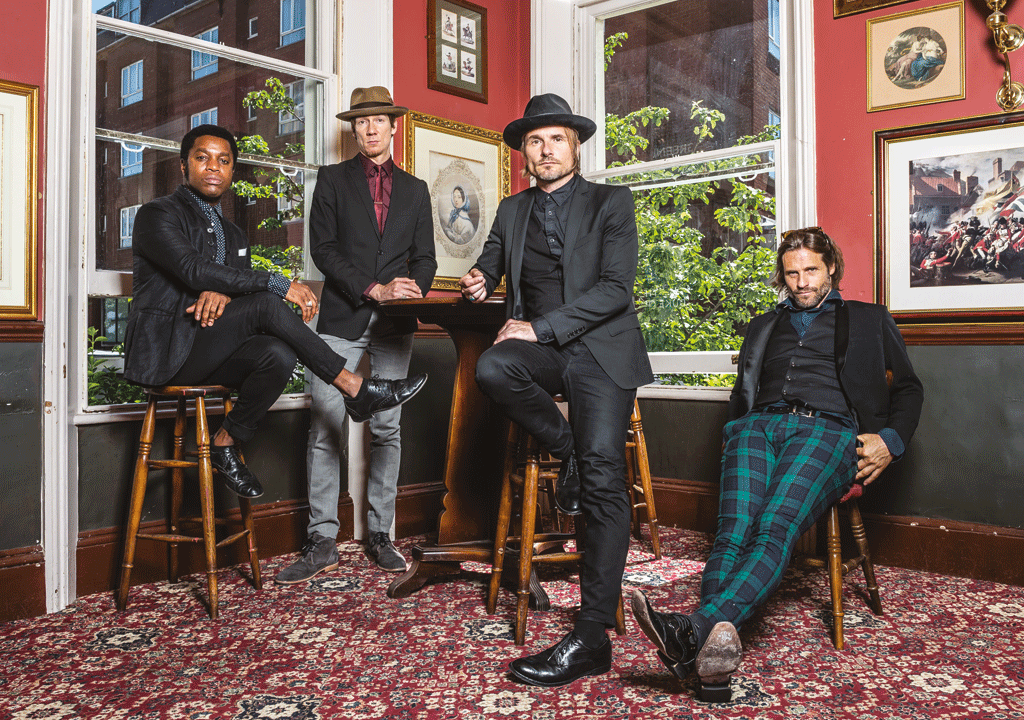
Vintage Style
The sharp-dressed men on the importance of decent threads.
Vintage Trouble don’t just sound classic – their sartorial style is so sharp you could cut yourself on their suits. “We all like clothes and fashion and design,” says Colt. “Suits are timeless as well. We all connected with it and it feels like you’re dressing up for the audience. You don’t go up in beach shorts and flip-flops like, ‘Let’s rock.’ I know a lot of bands that are really good that do that, but for us it feels important to have a red line through it even visually.”
Ty Taylor loves the physicality of a well-tailored suit. “If you have a suit on, there is always something in you that wants to break out,” he says “It’s the bull behind the gate waiting for the whole thing to start.”
And it’s not just the band looking good. Their fans, the Troublemakers, are following their lead.
“It’s this awesome ‘come dressy, leave messy’ thing,” says Dill. “There is something cool about getting all dressed up, looking sharp and feeling good inside yourself, going out and then by the end of the night you’re just a wreck, you’re a mess. That means you lived the fuck out of the night.”
